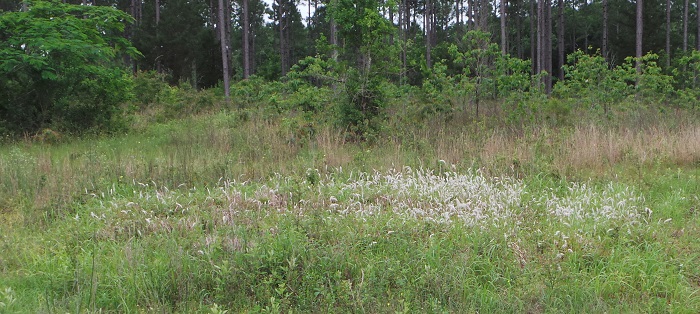Most of us have heard of invasive cogongrass (Imperata cylindrica). It arrived in the early part of the of the 20th century near Mobile Alabama and has spread across the lower southeast. It is an aggressive growing grass with serrated leaves and silica imbedded in its tissue. This makes it very undesirable for livestock and a threat to pastureland across the region – though there are reports of wild hogs consuming it. It can also invade timberlands where it burns hot during prescribed fires to a point where it can kill the trees you are trying to manage. It is considered one of America’s worst noxious weeds.

The abundance of this grass across the uplands of the Florida panhandle would indicate that it is far too established for eradication to occur. But what about the barrier islands? Is it a threat there and, if so, can it be eradicated?
I personally have seen the plant growing on Perdido Key in western Escambia County. I know of two locations where it currently resides. One is on public land, the other private, but we have not conducted a proper survey of the distribution on the Key at this point. Something we plan to do in 2023.
I also know it is found along Highway 98 at Gulf Islands Naval Live Oaks near Gulf Breeze in Santa Rosa County. I am not sure how many records the National Park has of the plant, or how widespread it is on the Gulf Breeze peninsula, nor do I know if it is on Santa Rosa Island/Pensacola Beach. Again, surveys are planned for 2023. We obviously need to know this before we can answer the question.
As of Nov 27, 2022 – there are 82,106 records of cogongrass in the U.S. – all are in the lower southeastern portion of the country. There are records as far north as North Carolina and as far west as the LA/TX line. Alabama is completely covered, as is much of the Florida panhandle.
As far as barrier islands, it is found on each of those within the state of Mississippi (10 records total). There are eight records on Dauphin Island AL, 16 on Ft. Morgan peninsula, eight in Gulf Shores AL proper, and nine in the Orange Beach AL area.
In Florida there are five records on Perdido Key proper, 13 more along the north shore of Big Lagoon, 125 along coastal NAS Pensacola, seven at Ft. Pickens on Santa Rosa Island in Escambia County, seven more at Naval Live Oaks in Gulf Breeze, six on Eglin property on Santa Rosa/Okaloosa Island, and 32 on Okaloosa Island between Ft. Walton and Destin. Here the western panhandle islands end. Between Perdido Key, Santa Rosa, and Okaloosa Islands proper – there are 50 records of the grass.
Along the coast between Okaloosa Island and Shell Island in Bay County, there are 44 records. There are no records on Shell Island itself but there are 86 records on Tyndall AFB. There is one record on Cape San Blas in Gulf County, one on St. Vincent Island and another along Highway 98 just west of Apalachicola in Franklin County. The barrier islands between Apalachicola and Bald Point have no records.
Based on this, the islands at the far eastern end of the panhandle should easily be able to eradicate these plants. The islands on the western end have more work to do, but a total of 50 records ON THE ISLANDS should be doable. This, of course, is based on the number of records being accurate, and I am sure they are under reported.
Step 1 – conduct surveys.
As with beach vitex, the first step is to accurately survey our islands to determine how widespread the problem really is, and then develop a management plan to possibly eradicate them.
Step – management
There are currently no known biological controls for this invasive plant.
Repeated disking and deep plowing have been shown to be effective in agricultural lands where it is possible to do. Mowing and/or burning when not in seed AND THEN CHEMICAL treatment has also had success. This should be done in the fall. Mechanical management alone has not been effective.
The chemical active ingredients of choice are glyphosate and/or imazapyr. As mentioned in the beach vitex article, imazapyr has a much longer soil activity and replanting cannot be achieved for several months. Replanting with native plants has been found to help control cogongrass but to do so quickly would require the use of glyphosate. In all studies, one chemical treatment was not enough.
This is a very tough noxious weed and early detection – rapid response (EDRR) is crucial at eradicating this species. We will begin Step 1 in Escambia County this year. If there are groups in other counties interested in doing the same, let us know and we will help where we can (roc1@ufl.edu).
- Tips for Bear Encounters this Fall - November 10, 2025
- Pensacola Bay Invasive Species Summer Survey 2025 - November 3, 2025
- Our Environment: Part 24 – Our Changing Climate - November 3, 2025
